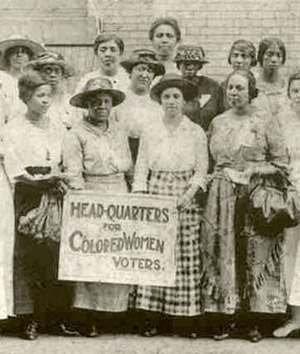Mobilizing the African American Community
Page Content

Nine African-American women pose with Nannie Burroughs holding a banner reading, “Banner State Woman’s National Baptist Convention” ca. 1910. (Courtesy of Library of Congress)
Nine African-American women pose with Nannie Burroughs holding a banner reading, “Banner State Woman’s National Baptist Convention” ca. 1910. (Courtesy of Library of Congress) 
Black women suffragists hold a sign reading "Head-Quarters for Colored Women Voters," in Georgia, ca. 1910. (Courtesy of New York Public Library)
Black women suffragists hold a sign reading "Head-Quarters for Colored Women Voters," in Georgia, ca. 1910. (Courtesy of New York Public Library) In the early years of the woman suffrage movement, African American women played a major role in campaigning for the vote. By 1920, most Black women lived in states were women lacked any voting rights. In an effort to redress this, African American women’s clubs sought strategies for gaining their enfranchisement. As the Black women’s club movement developed nationwide, a dialogue opened about common problems like intemperance, discrimination against African American women, and the local disenfranchisement of Black men at the polls.
As the movement picked up steam, African American women suffragists moved away from the abstract 19th-century argument that suffrage was a human right that all people deserved. They instead focused on what they perceived as the real issue – that African American women needed suffrage more than white women, because they were oppressed on the grounds of both sex and race.
The struggle for suffrage by African American women went beyond winning the vote and extended to using that vote as a tool on behalf of their community. Black suffragists believed the vote would allow them to advocate for better working conditions, higher wages, and greater opportunities in business. These women also believed they could regulate conditions for moral and sanitary reform in their communities better than outsiders. With political power, they argued, African American women could work to end racial discrimination, lynching, and legal injustice.
Next:
Indigenous Suffrage and Access >